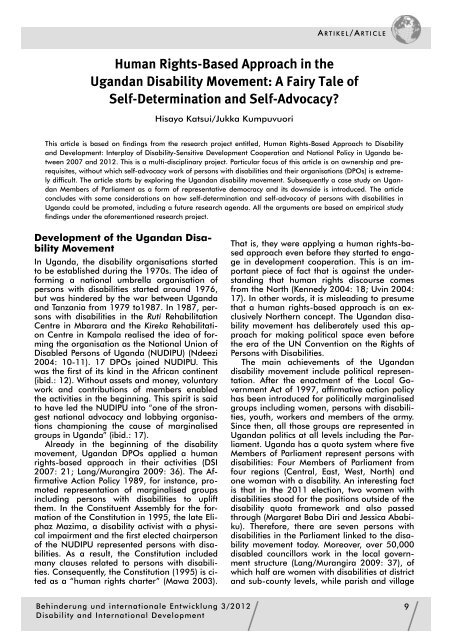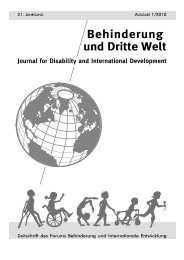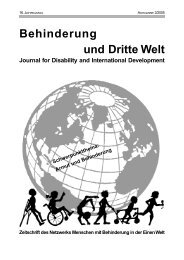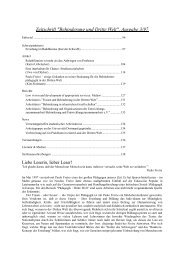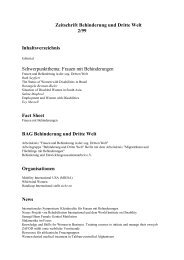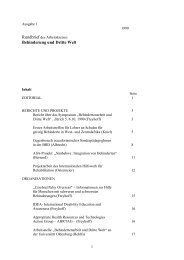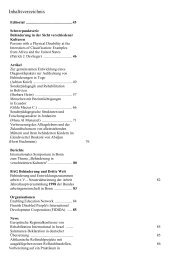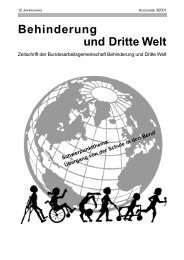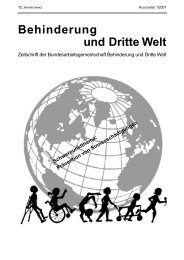Behinderung und internationale Entwicklung Disability and ...
Behinderung und internationale Entwicklung Disability and ...
Behinderung und internationale Entwicklung Disability and ...
You also want an ePaper? Increase the reach of your titles
YUMPU automatically turns print PDFs into web optimized ePapers that Google loves.
A RTIKEL/ARTICLEHuman Rights-Based Approach in theUg<strong>and</strong>an <strong>Disability</strong> Movement: A Fairy Tale ofSelf-Determination <strong>and</strong> Self-Advocacy?Hisayo Katsui/Jukka KumpuvuoriThis article is based on findings from the research project entitled, Human Rights-Based Approach to <strong>Disability</strong><strong>and</strong> Development: Interplay of <strong>Disability</strong>-Sensitive Development Cooperation <strong>and</strong> National Policy in Ug<strong>and</strong>a between2007 <strong>and</strong> 2012. This is a multi-disciplinary project. Particular focus of this article is on ownership <strong>and</strong> prerequisites,without which self-advocacy work of persons with disabilities <strong>and</strong> their organisations (DPOs) is extremelydifficult. The article starts by exploring the Ug<strong>and</strong>an disability movement. Subsequently a case study on Ug<strong>and</strong>anMembers of Parliament as a form of representative democracy <strong>and</strong> its downside is introduced. The articleconcludes with some considerations on how self-determination <strong>and</strong> self-advocacy of persons with disabilities inUg<strong>and</strong>a could be promoted, including a future research agenda. All the arguments are based on empirical studyfindings <strong>und</strong>er the aforementioned research project.Development of the Ug<strong>and</strong>an <strong>Disability</strong>MovementIn Ug<strong>and</strong>a, the disability organisations startedto be established during the 1970s. The idea offorming a national umbrella organisation ofpersons with disabilities started aro<strong>und</strong> 1976,but was hindered by the war between Ug<strong>and</strong>a<strong>and</strong> Tanzania from 1979 to1987. In 1987, personswith disabilities in the Ruti RehabilitationCentre in Mbarara <strong>and</strong> the Kireka RehabilitationCentre in Kampala realised the idea of formingthe organisation as the National Union ofDisabled Persons of Ug<strong>and</strong>a (NUDIPU) (Ndeezi2004: 10-11). 17 DPOs joined NUDIPU. Thiswas the first of its kind in the African continent(ibid.: 12). Without assets <strong>and</strong> money, voluntarywork <strong>and</strong> contributions of members enabledthe activities in the beginning. This spirit is saidto have led the NUDIPU into “one of the strongestnational advocacy <strong>and</strong> lobbying organisationschampioning the cause of marginalisedgroups in Ug<strong>and</strong>a” (ibid.: 17).Already in the beginning of the disabilitymovement, Ug<strong>and</strong>an DPOs applied a humanrights-based approach in their activities (DSI2007: 21; Lang/Murangira 2009: 36). The AffirmativeAction Policy 1989, for instance, promotedrepresentation of marginalised groupsincluding persons with disabilities to upliftthem. In the Constituent Assembly for the formationof the Constitution in 1995, the late EliphazMazima, a disability activist with a physicalimpairment <strong>and</strong> the first elected chairpersonof the NUDIPU represented persons with disabilities.As a result, the Constitution includedmany clauses related to persons with disabilities.Consequently, the Constitution (1995) is citedas a “human rights charter” (Mawa 2003).That is, they were applying a human rights-basedapproach even before they started to engagein development cooperation. This is an importantpiece of fact that is against the <strong>und</strong>erst<strong>and</strong>ingthat human rights discourse comesfrom the North (Kennedy 2004: 18; Uvin 2004:17). In other words, it is misleading to presumethat a human rights-based approach is an exclusivelyNorthern concept. The Ug<strong>and</strong>an disabilitymovement has deliberately used this approachfor making political space even beforethe era of the UN Convention on the Rights ofPersons with Disabilities.The main achievements of the Ug<strong>and</strong><strong>and</strong>isability movement include political representation.After the enactment of the Local GovernmentAct of 1997, affirmative action policyhas been introduced for politically marginalisedgroups including women, persons with disabilities,youth, workers <strong>and</strong> members of the army.Since then, all those groups are represented inUg<strong>and</strong>an politics at all levels including the Parliament.Ug<strong>and</strong>a has a quota system where fiveMembers of Parliament represent persons withdisabilities: Four Members of Parliament fromfour regions (Central, East, West, North) <strong>and</strong>one woman with a disability. An interesting factis that in the 2011 election, two women withdisabilities stood for the positions outside of thedisability quota framework <strong>and</strong> also passedthrough (Margaret Baba Diri <strong>and</strong> Jessica Ababiku).Therefore, there are seven persons withdisabilities in the Parliament linked to the disabilitymovement today. Moreover, over 50,000disabled councillors work in the local governmentstructure (Lang/Murangira 2009: 37), ofwhich half are women with disabilities at district<strong>and</strong> sub-county levels, while parish <strong>and</strong> village<strong>Behinderung</strong> <strong>und</strong> <strong>internationale</strong> <strong>Entwicklung</strong> 3/2012<strong>Disability</strong> <strong>and</strong> International Development9


